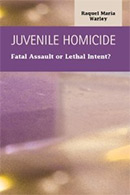Juvenile Homicide: Fatal Assault or Lethal Intent?

Author: Raquel Maria Warley
Publisher: El Paso, TX: LFB Scholarly Publishing LLC, 2011. 191p.
Reviewer: Patricia Cantara | March 2013
Why do adolescents kill? Youthful homicide offending has become a major public concern over the last few decades, yet very little research considers the role of weapons and offenders’ specific intent to harm in lethal outcomes involving juvenile offenders (2011). Warley seeks to address the concern of male on male adolescent violence by using a multi-perspective approach, referencing theory and background characteristics. The author uses quantitative data gathered from the Learning About Violence and Drugs among Adolescents project (LAVIDA) related to the prior experiences of juvenile males who were previously adjudicated delinquent for homicide or aggravated assault crimes. She looks at the characteristics of their violent crimes in order to better understand how the vital influence of culture and learning play a role in violent behavior for this specific youthful population.
Warley outlines several theoretical and conceptual foundations from which prior research has attempted to explain what predisposes adolescent males to violence. This framework includes strain theory, social disorganization, the subculture of violence thesis, criminal lethality and compulsory masculinity, as well as background and structural risk factors. Warley also differentiates between the crime characteristics of fatal assault, which she defines as “a physical attack that is escalated beyond the projected course of action,” compared to those of lethal intent — specific intent to kill. She argues that the weapon instrumentality effect hypothesis and the lethal intent thesis help differentiate between outcome results. However, the research conducted assumes that juvenile male homicides typically involve assaults with fatal outcomes. Her results support both the theoretical literature and empirical findings regarding male honor contest violence and the specific intent to do harm on incident outcomes such as aggravated assaults versus homicides.
Juvenile Homicide: Fatal Assault or Lethal Intent? would be a great addition to a course as supplemental literature on male-on-male violence, juvenile violence or violent behavior topics. The book is well structured and organized and will benefit both academics and students. The book is organized in a way that allows the reader to become more familiar with the problem in both a theoretical and conceptual framework, beyond any previous knowledge of the field. Warley also offers practical implications that seek to address the incidence and prevalence of juvenile homicide by focusing on five core elements: professional advocacy, community mobilization, social interventions, professional recruitment and development, and administrative leadership. The book concludes with suggestions for future research that will continue to address juvenile violence and future risk focused prevention that might better serve at risk youth, families and the communities in which they reside.
Patricia Cantara is a PhD Student at Rutgers University, School of Criminal Justice – Newark, NJ


